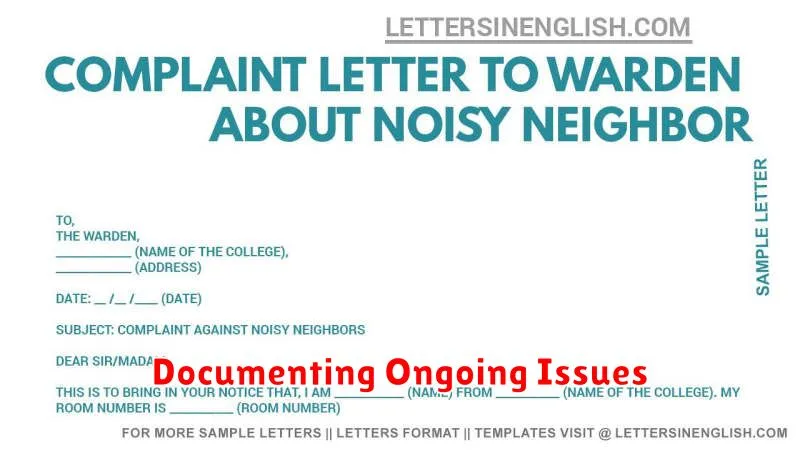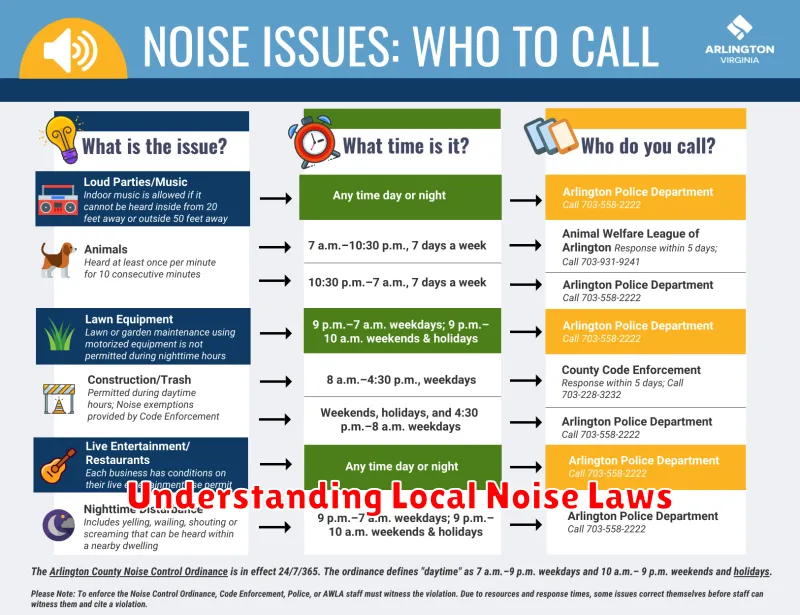Dealing with noisy neighbors in a rental property can be a significant source of stress. Whether it’s constant loud music, late-night parties, or the incessant barking of a dog, unwanted noise can disrupt your peace and quiet, affecting your sleep, concentration, and overall well-being. This article will provide you with practical strategies for handling noisy neighbors, outlining steps you can take to address the issue effectively and hopefully restore tranquility to your rental home. From understanding your rights as a tenant to navigating communication with your neighbors and landlord, we will cover the essential information you need to resolve noise complaints and reclaim your right to a peaceful living environment.
If you’re struggling with noise issues in your apartment or rental house, you’re not alone. Many renters experience disruptive neighbor noise, and knowing how to handle the situation appropriately is crucial. This guide will walk you through proven methods for dealing with noisy neighbors, including tips for effective communication, understanding your lease agreement, and involving your landlord or property manager when necessary. We’ll also explore strategies for documenting noise complaints and navigating potential legal avenues if other approaches prove unsuccessful. By following these guidelines, you can take proactive steps to address the noise problem and create a more harmonious living environment in your rental.
Recognizing What Counts as Noise Disturbance
Noise disturbance is generally defined as unwanted or excessive sound that interferes with an individual’s reasonable use and enjoyment of their property, or that violates established noise ordinances. This can encompass a wide range of sounds, from loud music and construction activities to barking dogs and noisy parties. The key factor is whether the noise is deemed unreasonable given the time, location, and prevailing community standards.
Determining whether a noise qualifies as a disturbance often depends on factors such as intensity (loudness), duration (how long it lasts), frequency (how often it occurs), and time of day. For example, a loud party late at night is more likely to be considered a disturbance than the same party during the afternoon. Similarly, continuous construction noise during weekdays might be acceptable, but the same noise on a Sunday morning could be a violation.
Local ordinances often specify acceptable noise levels and time restrictions. Consulting your local government’s website or contacting your municipality can provide specific details regarding noise regulations in your area. It’s important to remember that individual sensitivities to noise vary, but legal definitions of noise disturbance focus on what is deemed objectively unreasonable within the community.
Talk to Your Neighbors First
Before undertaking any potentially disruptive activity, such as construction, major landscaping, or hosting a large gathering, it’s crucial to communicate with your neighbors. This simple act of courtesy can prevent misunderstandings, build positive relationships, and avoid potential conflicts down the road. Giving them advance notice allows them to prepare and adjust their schedules accordingly, minimizing any inconvenience. Open communication fosters a sense of community and mutual respect.
When speaking with your neighbors, be clear and concise about your plans. Explain the nature of the activity, the expected duration, and any potential impacts such as noise or temporary access restrictions. Be receptive to their concerns and be willing to compromise where possible. A friendly and proactive approach can go a long way in ensuring a harmonious living environment.
By taking the time to talk to your neighbors first, you demonstrate consideration for their well-being and establish yourself as a responsible and respectful member of the community. This simple gesture can contribute significantly to a positive and peaceful neighborhood experience for everyone.
Documenting Ongoing Issues

Effective documentation of ongoing issues is crucial for tracking progress, identifying trends, and ultimately resolving problems. This involves recording details such as the issue’s description, date of occurrence, individuals affected, and any attempted solutions. Clear and concise language should be used to ensure understanding among all stakeholders. Regular updates are essential, noting any changes in status, new information discovered, or further steps taken.
A structured approach to documentation helps maintain consistency and facilitates analysis. This may involve using a dedicated issue tracking system, a shared spreadsheet, or even a simple log file. Regardless of the method chosen, the documentation should be easily accessible to those involved in the resolution process. Key information to include is the current status of the issue, the assigned owner responsible for its resolution, and the target resolution date.
Consistent and thorough documentation provides a valuable record of the issue’s lifecycle, which can be used for future reference and process improvement. By capturing all relevant details, teams can learn from past experiences, identify recurring problems, and implement preventative measures. This promotes a more proactive approach to issue management and contributes to overall organizational efficiency.
Contacting Your Landlord or Property Manager

Open communication with your landlord or property manager is crucial for a positive renting experience. Whether you need to report a maintenance issue, ask a question about your lease, or discuss a concern, understanding the proper channels and procedures for contact is essential. Always refer to your lease agreement for specific instructions regarding communication protocols, as these can vary depending on your individual agreement and local laws. This document often outlines preferred methods of contact (e.g., phone, email, online portal), designated contact persons, and acceptable hours for communication.
When contacting your landlord or property manager, be clear and concise in your communication. Clearly state the reason for your contact, providing relevant details such as dates, times, and specific locations within the property. Maintain a respectful and professional tone throughout your interaction. Documenting all communication attempts, including dates, times, and the nature of the conversation, is highly recommended. This documentation can be invaluable should any disputes or misunderstandings arise in the future.
If your initial attempts to contact your landlord or property manager are unsuccessful, consider following up with a written communication, preferably via certified mail. This provides a record of your attempt to contact them. Remember to familiarize yourself with your local tenant laws, which outline your rights and responsibilities as a tenant, including acceptable timelines for landlord responses to maintenance requests and other concerns. If you are unable to resolve the issue directly, consider contacting your local tenant’s rights organization for further assistance.
Understanding Local Noise Laws

Noise pollution is a serious issue that can disrupt peace and negatively impact quality of life. To combat excessive noise, communities establish local noise ordinances, also known as noise laws. These regulations define acceptable noise levels at different times of the day and in various locations. Understanding and respecting these laws is crucial for maintaining a harmonious living environment for everyone. Key elements often addressed in noise ordinances include construction noise, amplified music, vehicle noise, and residential noise levels. Penalties for violating these regulations can include warnings, fines, and even legal action.
Local noise ordinances typically distinguish between daytime and nighttime hours, with stricter limits imposed during nighttime hours when people are more likely to be sleeping. These ordinances may also specify acceptable decibel levels for different activities. For example, construction activities might be permitted during daytime hours but prohibited during nighttime hours. Similarly, amplified music might be allowed at certain decibel levels during the day, but significantly restricted at night. It’s essential to consult your local government’s website or contact the appropriate authorities to determine the specific noise regulations in your area.
By being mindful of noise levels and adhering to local noise ordinances, we can contribute to a more peaceful and respectful community. If you believe a neighbor is violating a noise ordinance, it’s generally recommended to first attempt to resolve the issue amicably. If this proves unsuccessful, you can then contact the relevant local authorities, such as the police department or a designated noise control officer, to investigate and address the situation. Remember, cooperation and consideration are key to maintaining a quiet and enjoyable environment for everyone.
When to Involve Authorities
It’s crucial to involve authorities when a situation poses a threat to public safety or involves illegal activity. This includes instances of violent crime, suspected abuse (child, elder, or domestic), or witnessing a crime in progress. If you are unsure, it’s always best to err on the side of caution and contact the appropriate authorities. Your quick action can help prevent escalation and ensure the safety of those involved.
Beyond immediate danger, authorities should be contacted in situations involving significant property damage, such as major traffic accidents or suspected arson. Additionally, certain situations like encountering a lost or missing person, especially a vulnerable individual, warrant contacting authorities to help facilitate a safe return. In these cases, providing accurate and detailed information to authorities is essential.
While not always requiring immediate involvement, authorities should be informed of potential hazards or suspicious activities. This could include observing individuals engaging in suspicious behavior, discovering abandoned property, or identifying potential safety risks in public spaces. Reporting these observations can assist authorities in preventing potential crimes and maintaining community safety. Remember, you are a valuable resource in helping keep your community safe.
Maintaining a Peaceful Living Space
Creating a peaceful living space is essential for overall well-being. It provides a sanctuary from the stresses of daily life and promotes relaxation and rejuvenation. Decluttering is a key first step. A tidy space free of unnecessary items promotes a sense of calm and control. Consider incorporating elements that engage your senses positively, such as calming colors, soft textures, and pleasant scents. Minimize noise pollution by using sound-absorbing materials or incorporating white noise machines. Establishing boundaries around work and technology use within the space can also significantly contribute to its tranquility.
Personalization plays a vital role in fostering a sense of peace. Decorate with items that bring you joy and evoke positive emotions. This could include cherished photographs, inspiring artwork, or objects from nature. Consider incorporating elements that promote mindfulness and introspection, such as a designated meditation area or a comfortable reading nook. Ensure adequate natural light and ventilation to create a fresh and invigorating atmosphere. Plants can also enhance the peacefulness of a space by bringing a touch of nature indoors and improving air quality.
Maintaining a peaceful living space requires consistent effort. Regular cleaning and tidying are essential to prevent clutter from accumulating and disrupting the sense of calm. Periodically reassess your space and remove any items that no longer serve you or contribute to a peaceful atmosphere. Adjusting lighting, scents, and other sensory elements can help to refresh the space and maintain its calming effect. By prioritizing the peacefulness of your living space, you are investing in your overall well-being and creating a haven for relaxation and rejuvenation.

